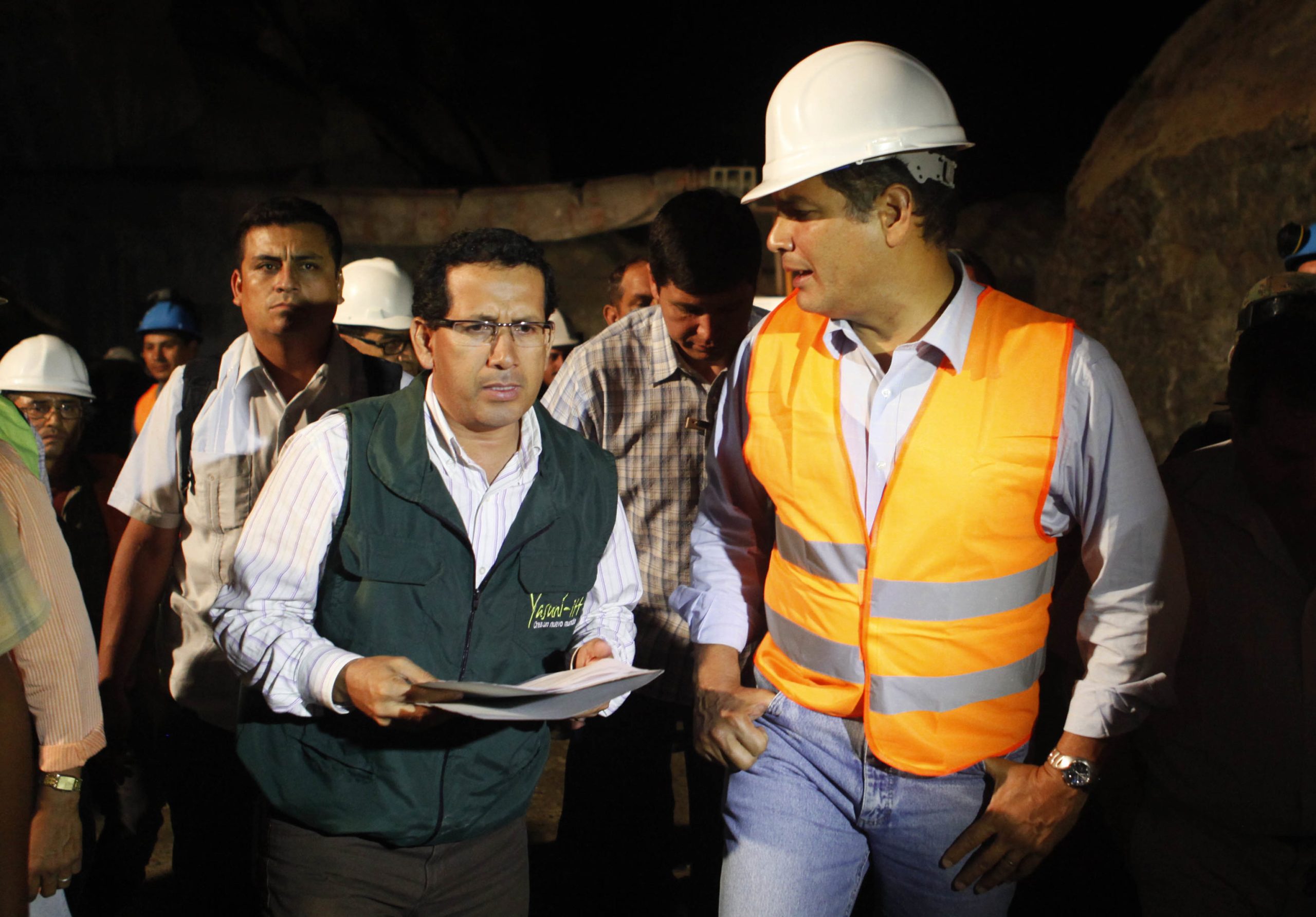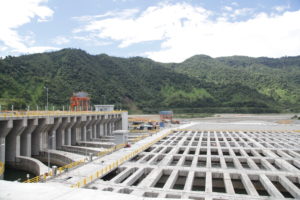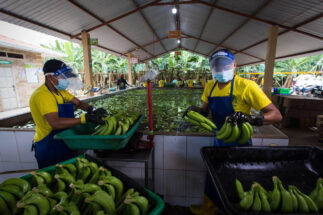In March 2022, Ecuador was shaken by the news that the Chinese state-owned China International Water & Electric Corporation (CWE), the last company to preside over the Toachi Pilatón hydroelectric project, was suing the country for US$100 million. The reason: Ecuador’s decision to unilaterally terminate the contract with the company.
CWE litigated against the Ecuadorian state electricity holding company (Celec) for “breaches of contract”, such as delays in paying wages. Celec, for its part, accuses CWE of a series of failures: in the dam’s waterproofing barriers and control and lighting systems; for accumulating hazardous waste; and its non-compliance with an environmental management plan.
In an interview with Diálogo Chino, Gonzalo Uquillas, who until this week was Celec’s general manager, said that, despite the five changes in government since construction of the mega-project began in 2008, the state has fulfilled its contractual obligations and the “companies [formerly involved in construction] are the ones that have not taken responsibility”.
Toachi Pilatón: The beginnings
The story of Toachi Pilatón is a saga that involves many ruptures and setbacks. In the early 1960s, the first feasibility studies were carried out for a hydroelectric plant that promised to provide energy to rural and urban areas in Ecuador’s highlands. Yet, it took several decades for construction to begin. It is not the only stop-start case in Ecuador’s promised hydropower revolution.
During the three governments of Rafael Correa (2007-2017), Ecuador announced the construction of eight hydroelectric plants aimed at overhauling the energy matrix and promoting energy security. Aside from the Odebrecht-built Manduriacu plant, all of them – Sopladora, Coca Codo Sinclair, Delsitanisagua, Mazar-Dudas, Minas San Francisco, Quijos, and Toachi Pilatón – are partially or wholly owned by Chinese contractors.
Yet, at present only four – Manduriacu, Sopladora, Coca Codo Sinclair and Delsitanisagua – are operational, albeit with structural problems. The rest are still delayed, such as Toachi Pilatón, one of the so-called emblems of this new energy era.

“President Correa has given a lot of ground, but in the end Odebrecht cannot be in the country. We have analysed everything and we believe that it is not possible to continue,” declared Galo Borja, then coordinating minister of Strategic Sectors, at the time, years before the Brazilian company’s extensive international corruption network was revealed.
From its controversial beginnings, Toachi Pilatón became a dream that no one has been able to realise.
The importance of Toachi Pilatón
Toachi Pilatón is located in the centre of Ecuador between the provinces of Pichincha, Santo Domingo de los Tsáchilas and Cotopaxi, a two-hour drive from the capital Quito. It is considered fundamentally important by the state “as it is complementary to the hydroelectric plants in the eastern cordillera [mountain ranges], when these enter low water levels,” according to Celec.
The project includes two generation plants: the 49MW Sarapullo plant, the first to enter commercial operation, in April 2022, and Alluriquín, which has an installed capacity of 204MW.
“It will take advantage of the ecological flow discharged by the Toachi dam, with the installation of a mini power plant of 1.4 megawatts, giving a total of 254.4 megawatts of installed power, which will contribute 1,100 gigawatt-hours of average annual energy to the National Interconnected System,” a 2019 statement from the Ministry of Energy read.
According to the energy ministry, if it is eventually fully operational, Toachi Pilatón will reduce thermal generation and energy imports from Colombia. It is also expected to reduce the use of petroleum-based fuels and the outflow of foreign currency to pay for energy imports. Finally, it says it will incorporate efficient hydroelectric and thermoelectric generation as a matter of urgency, eliminating restrictions or blackouts on the national grid.
Second round of construction
After Odebrecht’s departure, in 2010 works were awarded to a Chinese-Russian consortium formed by CWE and Inter Rao. The Banco del Instituto Ecuatoriano de Seguridad Social (Biess) and Russia’s Eximbank would provide the finance. The Chinese company would be responsible for executing the works and the Russian company for the installation and commissioning of the electromechanical equipment.
However, in 2017, once again unilaterally, Ecuador decided to terminate the contract with Inter Rao due to a series of breaches. The Russian company was forced to stop work and consequently sued Ecuador for US$86 million. The case is progressing slowly through the courts. Toachi Pilatón, which should have been completed in 2015, saw work suspended for the next two and a half years.
In 2019, Ecuador signed another contract with the Russian company Tyazhmash, replacing Inter Rao in the provision and assembly of electromechanical equipment at the plant. The company would join CWE to deliver Toachi Pilatón once and for all. However, in recent weeks, Ecuador decided to terminate the contract with CWE, yet again putting works on hold.
Failures
Celec decided to break with CWE due to structural flaws that it claims the Chinese company did not address. Furthermore, the Comptroller’s Office, a state supervisory body, reported fissures, cracks and landslides that compromised the power plant and rendered it inoperable.
Uquillas, Celec’s former top official, said CWE did not remedy cracks that appeared in the nine-kilometre water loading tunnel.
US$920 million
The cost, without tax, of Toachi Pilatón project, up to April of this year – without even having operated for a single day
Similarly, the slopes around Alluriquín’s upper balance chimney – a key structure in preventing surges in water pressure – are unstable. “This impedes the operation of the plant,” said Uquillas.
“The Chinese contractor did not work on solutions to stabilise the slopes and the Comptroller’s Office warns that there is a risk of chimney collapse,” he said, adding that there were irregularities in the execution of the waterproofing barriers for the Pilatón water intake and the Toachi dam.
Diálogo Chino tried to contact CWE representatives in Ecuador, but they did not respond to our requests by the time of publication.
Specialists and former officials consulted for this article said that Toachi Pilatón symbolises the squandering of public money that took place during the Correa government. “It all started badly,” hydroelectric expert Emilio Cevallos told Diálogo Chino, adding that technical criteria took second place to political alignment.
Martín Pérez Algarra, a political analyst, said: “It was an ideological contracting process: only Chinese, Russian or Brazilian companies were called in. In other words, those that were in line with the then misnamed ‘socialist’ regime of the Citizen’s Revolution that Correa created.”
Now, the situation has begun to worry experts and government leaders as Ecuador and China seek to bolster their bilateral relations. “The disagreements between the two state-owned companies put at risk the oil, energy and trade agreements that Ecuadorian President Guillermo Lasso and his counterpart Xi Jinping discussed during his recent trip to China in February,” said Cevallos.
Celec is also currently suing China’s Sinohydro for problems at the Coca Codo Sinclair plant.
What’s next for Toachi Pilatón?
As of April 2022, Toachi Pilatón has cost more than US$920 million. Although if taxes, such as the 12% rate of VAT are taken into account, the project has cost the state more than $1 billion.
Celec reports that between December and January last year, it carried out synchronisation tests – connecting power generation units to the National Interconnected System – as a precursor to the full electricity production process.
“Overcoming a series of stoppages in the construction process, this is finally the first time that this project has delivered electricity to the National Interconnected System,” said Uquillas.
Toachi Pilatón is a monument to waste. It still doesn’t work. Its facilities are abandoned. It does not generate a single kilowatt of energy
The Alluriquín powerhouse, which will have an installed capacity of 204MW, is expected to come into operation in the second half of 2022. Yet, Uquillas admits, there is no date and no certainty on when Toachi Pilatón will become fully operational.
Currently, it is not even operating at a quarter of the planned level, tests showed. Cevallos believes that the giant structure will be another “white elephant” that evidences the misuse of public resources.
Researcher Arturo Torres, who has investigated the issue for his digital portal, Código Vidrio, said: “Toachi Pilatón is a monument to waste. It still doesn’t work. Its facilities are abandoned. It does not generate a single kilowatt of energy, but it did cause a short circuit in the country.”
He added: “It was the first bribery scandal linked to a former official of Rafael Correa’s government. The former Minister of Electricity, Alecsey Mosquera, received – according to court documents – one million dollars from the Brazilian construction company [Odebrecht] as a bonus.”
With the departure of CWE, the Ecuadorian state will most likely seek another company to finish the unfinished work and repair the faults. The saga continues.









